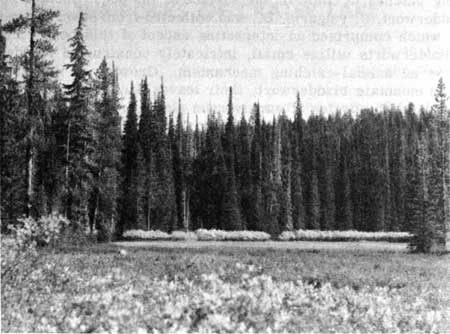Botrychium
Botrychium is the generic name for a group of fern-allies called grape-ferns from the sporangia clustered like bunches of grapes. It is classified with the Adder’s Tongue Family, OPHIOGLOSSACEAE, each of whose members has an underground stem reduced to a short rootstock. A single leaf appears each year that is divided into a foliage part and a sporebearing spike or panicle that faces the former. The bud for the succeeding year’s frond grows within the base of the stalk or petiole of the leaf, and is circinate, that is, rolled downward from the apex.
The Crater Lake grape-fern was the object of avid search by the park’s scientist of promise, my budding sixteen-year-old helper, Roy Rogers. In his narration, he tells of its provision for existence in a rugged, exposed situation. Quite larger in size, growing in moister, kindlier situations is the leathery grape-fern, B. silaifolium Presl, that frequents shaded banks and sphagnum bogs from New England to California and north to Alaska. Great variation in size occurs among individual plants that cannot be referred to character of climate and soil.
On our botanical survey of the Siskiyous near Oregon Caves, Dr. Wm. S. Baker and I found this plant growing in a mossy site at the outlet of Lower Biglow Lake. I made a half-dozen hikes to the place before securing spore bearing specimens. This year, James Kezer added it to the park flora. He collected it at Spruce Lake and in the sphagnum bogs near Crater Spring, well within the park boundaries. Kezer’s specimens have been examined and classified by Dr. Robert Clausen of Cornell University as B. multifidum ssp. silaifolium (Presl) Clausen.
Additions to the Flora
By James Kezer, Ranger-Naturalist
 A bog in the vicinity of Crater Spring.
A bog in the vicinity of Crater Spring.
(CRATER LAKE NATIONAL PARK – 1951)
One of the exciting experiences of the 1951 season was the discovery of a large area of sphagnum bogs in the northwestern part of the park It is not surprising that ten plants previously unknown from the park were found in this new and distinctive kind of habitat.
On the evening of September 14, Lawrence Bisbee, Fred Larmie and I explored a remote and seldom visited region of the park south of Crater Spur Motorway in search of a pond that had been reported in 1937 by Dr. Applegate. About one-quarter mile south of the motorway spur we entered an extensive, beautiful, wet montane meadow that was characterized by boggy areas covered with sphagnum moss. Although exact measurements were not made, we estimated that the meadow extended over at least ten or fifteen acres.
To the northeast, it was bounded by a row of alpine firs below which was a hedge of willows that looked as though it had been planted and clipped. Growing abundantly in the sphagnum was a carnivorous plant, mountain bladderwort, Utricularia intermediaHayne, its yellow flowers forming patches of color on the surface of the bog. Another species of bladderwort, U. vulgaris, L., was collected from several small bog ponds which comprised an interesting aspect of this boggy meadow. The bladderworts utilize small, intricately constructed bladder-like traps as an animal-catching mechanism. Growing in the sphagnum with the mountain bladderwort, their leaves forming patches of red, were two other species of carnivorous plants, round-leaved sundew, Drosera rotundifolia L., (previously known in the park only from Copeland Meadow) and long-leaved sundew, D. longifolia L. The sundews have glandular hairs on their leaves which provide them with a flypaper-like secretion in which small animals become entrapped. In the ponds with the bladderwort was a pondweed, Potamogeton pusillus L., and in the nearby wet sphagnum were a few plants of the marsh cinquefoil, Comarum palustre L.
A number of days later, I returned to Crater Spring and hiked along the northern side of the creek toward the western boundary of the park. A very short distance from the spring I entered another boggy meadow that extended at least one-half mile along the creek. In nearly every respect it was similar to the sphagnum meadow that had been previously discovered; however, it contained a bog pond that differed considerably from those present in the meadow south of Crater Spur Motorway. This was a body of water about 120 feet in diameter, surrounded by a floating mat of vegetation which extended into the pond as its bottom. The mat of vegetation was so fragile that it would not support my weight and it made collecting in the pond extremely difficult. An abundant growth of sedges and aquatic plants protruded through the water’s surface, leaving only small patches of open water. Buckbean, Menyanthes trifoliata L., was growing in the sphagnum around the pond with marestail, Hippuris vulgaris L., and the floating pondweed, Potamogeton natans L., conspicuous in the water among the sedges. A small burr-reed Sparganium minimum Fries, was also growing in the pond. At the edge of the water, in the mud of the floating mat of vegetation, were a few clumps of stick-tight,Bidens cernua L.
It is highly probable that a more detailed exploration of these two areas will yield other plants that have not been reported from the park.
It should be emphasized that the areas in which these new plants were found represent a totally new habitat for the park. Sphagnum bogs were previously unreported within the boundaries of the park; furthermore, the park contains only one permanent pond (discussed elsewhere in this issue of Nature Notes) other than these Crater Creek bog ponds. There can be no doubt that these newly discovered bogs and ponds, with their distinctive plants and animals, add to the biological significance of this magnificent National Park.

